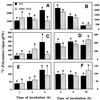Metabolism of polyamines in transgenic cells of carrot expressing a mouse ornithine decarboxylase cDNA
- PMID: 9449846
- PMCID: PMC35170
- DOI: 10.1104/pp.116.1.299
Metabolism of polyamines in transgenic cells of carrot expressing a mouse ornithine decarboxylase cDNA
Abstract
The metabolisms of arginine (Arg), ornithine (Orn), and putrescine were compared in a nontransgenic and a transgenic cell line of carrot (Daucus carota L.) expressing a mouse Orn decarboxylase cDNA. [14C]Arg, [14C]Orn, and [14C]putrescine were fed to cells and their rates of decarboxylation, uptake, metabolism into polyamines, and incorporation into acid-insoluble material were determined. Transgenic cells showed higher decarboxylation rates for labeled Orn than the nontransgenic cells. This was correlated positively with higher amounts of labeled putrescine production from labeled Orn. With labeled Arg, both the transgenic and the nontransgenic cells exhibited similar rates of decarboxylation and conversion into labeled putrescine. When [14C]putrescine was fed, higher rates of degradation were observed in transgenic cells as compared with the nontransgenic cells. It is concluded that (a) increased production of putrescine via the Orn decarboxylase pathway has no compensatory effects on the Arg decarboxylase pathway, and (b) higher rates of putrescine production in the transgenic cells are accompanied by higher rates of putrescine conversion into spermidine and spermine as well as the catabolism of putrescine.
Figures







References
-
- Altman A. The physiology of polyamines. In: Bachrach U, Heimer YM, editors. Polyamines and Plant Hormones, Vol 2. Boca Raton, FL: CRC Press; 1989. pp. 121–145.
-
- Altman A, Levin N. Interactions of polyamines and nitrogen nutrition in plants. Physiol Plant. 1993;89:653–658.
-
- Bagni N, Pistocchi R (1990) Binding, transport, and subcellular compartmentation of polyamines in plants. In HE Flores, RN Arteca, JC Shannon, eds, Polyamines and Ethylene: Biochemistry, Physiology, and Interaction. American Society of Plant Physiologists, Rockville, MD, pp 62–72
-
- Bastola DR (1994) Genetic engineering of the polyamine biosynthetic pathway and somatic embryogenesis in carrot (Daucus carota L.). PhD Thesis, University of New Hampshire, Durham
MeSH terms
Substances
LinkOut - more resources
Full Text Sources
Other Literature Sources

